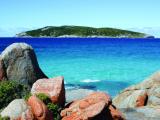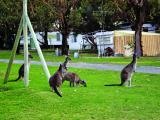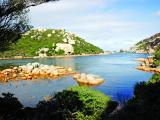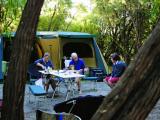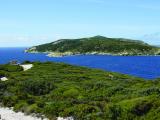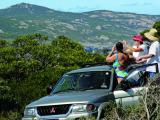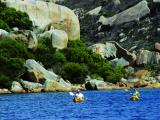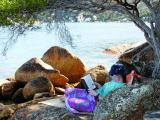A Whale of a Time
28 June 2010
The southern coast of Western Australia is a diverse mix of river mouths with sandbars, granite cliffs that plunge into the sea, rocky headlands and sweeping deserted beaches. This diverse mix of scenery is particularly obvious between Albany and Esperance.
Located only 70km east of Albany is the tiny fishing village of Cheyne Beach. Being off the main drag and so close to Albany, many people plant the foot and hurtle past the turnoff. By not taking that turnoff they are missing out on one of the south coast’s truly delightful locations.
For most of its life, Cheyne Beach has survived as a fishing and holidaying location for those in the know. But Cheyne Beach’s European history goes back quite a long way. In the 1840s, a whaling station, called the Cheyne Beach Whaling Company, was established in this area. It lasted only 30 years before being relocated closer to Albany. The whaling boats that are now part of Whale World in Albany are all named Cheyne.
Due to its proximity to Albany, it is possible to sample the delights of Cheyne Beach on an action-packed daytrip. But, if you desire a more laidback escape from the hustle and bustle of Albany, we recommend staying a couple days. There is a lot to see and do.
The sealed Cheyne Beach Road approach to the settlement gives a hint of what’s to come as you pass by scrub cloaked hills topped by granite outcrops. To the right are glimpses of an impressively rugged mountain. This is Mount Manypeaks, which was named by Captain Matthew Flinders in January 1802.
On the left, bordering a sweeping bay, is a line of rustic fishing shacks with views to kill for. The only (tiny) shop is attached to the Cheyne Beach Caravan Park. Locals head for Albany for their big shopping hit. The Cheyne Beach Caravan Park is one of those places that are great to take international visitors to. Kangaroos come out en masse in the late afternoon and evening to graze on the lawn surrounding the ablution blocks.
While having dinner, you may even get a visitation from another marsupial, the bandicoot. Just over the road, we stood in awe gazing at a huge but harmless carpet python effortlessly moving through some banksia trees.
The whole area has a spectacular display of wildflowers between September and November. Even outside spring months, there are good displays of wildflowers.
Between Cheyne Beach and Mount Manypeaks is Waychinicup National Park. The tiny 10km-long Waychinicup River is popular with nature lovers. Unlike most rivers on the south coast, the Waychinicup is not blocked by a sand bar as it enters the sea. It instead flows out to sea past a bastion of rock cliffs.
The river itself is lined by huge boulders, some of which are tainted orange from tannins in the water. Fishing, swimming, kayaking and absorbing the sun are popular pastimes here. Wildlife, particularly bandicoots, is quite friendly around campsites. Resist the temptation to feed them.
Down near the mouth of the Waychinicup River, the Department of Environment and Conservation (DEC) has created a small campground. The campsite is not suitable for caravans, but DEC has cleared small level tent sites in secluded picturesque places.
To get the most out of the Cheyne Beach region, it is best to have a four wheel drive or good walking shoes. The caravan park has mud maps that give a rough guide to where tracks in the area go.
Just behind the caravan park is a sand track. This is the loop trail that reveals the wonders of the south coast. Before the loop is a track of less than a kilometre leading direct to the aptly named Back Beach. The beach is around 1km in length with a granite headland at each end.
As we can verify, autumn and winter months are the times to get stuck into tough fighting Australian salmon. You can fish for them off the beach, or rocks at Back Beach if you take care. Beware of freak or king waves when fishing on rocks anywhere along the south coast. The WA variety of Australian salmon is much bigger than its eastern states’ cousin, so be prepared for a good fight.
Fishing is not the only highlight around here. Backtrack and turn left up the hill to the Lookout Point. It’s a steep drive with rocky parts that need careful negotiating. From the top of the cliff, there’s a fantastic view overlooking the nature reserve of Bald Island. A deep channel between the mainland and the island seems to be a popular avenue for migrating humpback and southern right whales. Little wonder that this spot was used during the whaling years for whale spotting. ‘Thar she blows!’
The full 4WD track of 13km loops around the peninsula and, although short, is a spectacular drive. Take the sandy loop slowly, as each hill or turn reveals superb views of the rocky headlands, nearby islands and coastal heath with wildflowers. The track is only one car wide, but pretty quiet, so hopefully you won’t meet other cars. Nevertheless, take care and keep speed down.
The first part of the track has great views of Bald Island to the right and unusual granite rock formations to the left. The highest point of the peninsula is just over 200m. As the track comes to the western side of the peninsula, Mermaid Beach and Mermaid Point come into view. For those who would like to catch a glimpse of a mermaid, find another location – Mermaid beach and Point were named after HMS Mermaid that passed by in 1818.
Tracks off to the right go down to the beach and it is a sandy 3km round trip. A creek runs down the western side of the hill and in one location there is a puddle of varying depth on the track.
After rain, this puddle becomes quite deep and very muddy with steep, hidden sides. The trouble is it doesn’t look that bad. Many an adventurous 4WDer has become stuck, thanks to the puddle’s radical approach and departure angles. Locals are now understandingly charging to come and pull them out. A side track has been created and although it may be a tad tamer, it will cost you less in the end.
The next highlight is a track well worn by experienced local surfers. Beautifully formed sets of waves crash into a piece of coast known locally as ‘Bamboos’. The surfers come directly from the Cheyne Beach Road, avoiding the longer scenic drive.
From the cliff above Bamboos, there is a great view of Mount Manypeaks, which is also in a nature reserve, but inaccessible by a vehicle. Mount Manypeaks protects a vast array of rare fauna and flora. One of the most famous is the highly endangered noisy scrub bird. When the noisy scrub bird was discovered during the 1960s, a town planned for the area was scrapped.
The 4WD trail is huge highlight in the region, but if you don’t have one, not to worry. There’s still plenty to see and do. On the other hand, you can always put on the walking boots. The 4WD trail is steep and sandy in parts but well worth it if you are into hiking. Allow the day if doing it on foot and be well prepared.
The Cheyne Beach region combines compactness with great natural beauty. Stay a few days and you will be reluctant to move on.
CHEAP TREATS
Great Southern Distilling Company
52 Frenchman Bay Road, Albany.
Open daily from 9.30am until 5pm with 7.30pm close on Friday and Saturday night. A small tasting fee applies.
JJ Tours Guided Walking Tours
Proudlove Pde, Albany. Allow two hours.
Adults $18, Concessions $15, Children $5.
(08) 9841 3180 or 0407 387 484.
TOURIST INFORMATION
Cheyne Beach Caravan Park
Unpowered and powered sites
Cabins
Cheyne Beach Road, Cheyne Beach
(08) 9946 1247
[email protected]
www.cheynesbeachcaravanpark.com.au
CALM Ranger
Based at Two Peoples Bay Road,
Via Albany WA 6330
(08) 9846 4276
CALM South Coast Regional Office
120 Albany Highway, Albany
(08) 9842 4500
BEST TIME TO VISIT
Cheyne Beach and Waychinicup National Park
August to November for wildflowers
June to October for whale watching
FREE ATTRACTIONS
Waychinicup National Park
Norman’s Beach
Waychinicup Inlet
Mt Manypeaks
Sealer’s Oven
The Amity (a restored ship from 1826)
For maps and details, contact:
Albany Visitor Centre
PO BOX 5721, Albany WA 6332
Tel: (08) 9841 9290
Email: [email protected]
Web: www.albanytourist.com.au






